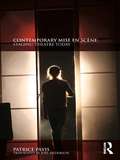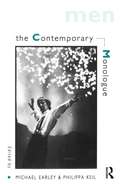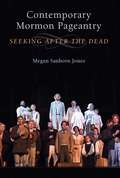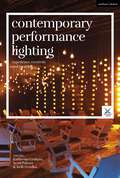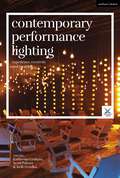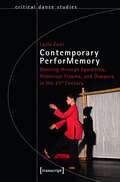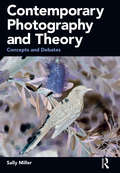- Table View
- List View
Contemporary Library Architecture: A Planning and Design Guide
by Ken WorpoleFocusing on the practical issues which need to be addressed by anyone involved in library design, here Ken Worpole offers his renowned expertise to architects, planners, library professionals, students, local government officers and members interested in creating and sustaining successful library buildings and services. Contemporary Library Architecture: A Planning and Design Guide features: a brief history of library architecture an account of some of the most distinctive new library designs of the 20th & 21st centuries an outline of the process for developing a successful brief and establishing a project management team a delineation of the commissioning process practical advice on how to deal with vital elements such as public accessibility, stock-holding, ICT, back office functions, children’s services, co-location with other services such as learning centres and tourist & information services an sustainability in depth case studies from around the world, including public and academic libraries from the UK, Europe and the US full colour illustrations throughout, showing technical details and photographs. This book is the ultimate guide for anyone approaching library design.
Contemporary Library Architecture: A Planning and Design Guide
by Ken WorpoleFocusing on the practical issues which need to be addressed by anyone involved in library design, here Ken Worpole offers his renowned expertise to architects, planners, library professionals, students, local government officers and members interested in creating and sustaining successful library buildings and services. Contemporary Library Architecture: A Planning and Design Guide features: a brief history of library architecture an account of some of the most distinctive new library designs of the 20th & 21st centuries an outline of the process for developing a successful brief and establishing a project management team a delineation of the commissioning process practical advice on how to deal with vital elements such as public accessibility, stock-holding, ICT, back office functions, children’s services, co-location with other services such as learning centres and tourist & information services an sustainability in depth case studies from around the world, including public and academic libraries from the UK, Europe and the US full colour illustrations throughout, showing technical details and photographs. This book is the ultimate guide for anyone approaching library design.
Contemporary Masculinities in Fiction, Film and Television
by Brian BakerWhile masculinity has been an increasingly visible field of study within several disciplines (sociology, literary studies, cultural studies, film and tv) over the last two decades, it is surprising that analysis of contemporary representations of the first part of the century has yet to emerge. Professor Brian Baker, evolving from his previous work Masculinities in Fiction and Film: Representing Men in Popular Genres 1945-2000, intervenes to rectify the scholarship in the field to produce a wide-ranging, readable text that deals with films and other texts produced since the year 2000. Focusing on representations of masculinity in cinema, popular fiction and television from the period 2000-2010, he argues that dominant forms of masculinity in Britain and the United States have become increasingly informed by anxiety, trauma and loss, and this has resulted in both narratives that reflect that trauma and others which attempt to return to a more complete and heroic form of masculinity. While focusing on a range of popular genres, such as Bond films, war movies, science fiction and the Gothic, the work places close analyses of individual films and texts in their cultural and historical contexts, arguing for the importance of these popular fictions in diagnosing how contemporary Britain and the United States understand themselves and their changing role in the world through the representation of men, fully recognising the issues of race/ethnicity, class, sexuality, and age. Baker draws upon current work in mobility studies and in the study of masculinities to produce the first book-length comparative study of masculinity in popular culture of the first decade of the twenty-first century.
Contemporary Masculinities in Fiction, Film and Television: Film, Fiction, And Television
by Brian BakerWhile masculinity has been an increasingly visible field of study within several disciplines (sociology, literary studies, cultural studies, film and tv) over the last two decades, it is surprising that analysis of contemporary representations of the first part of the century has yet to emerge. Professor Brian Baker, evolving from his previous work Masculinities in Fiction and Film: Representing Men in Popular Genres 1945-2000, intervenes to rectify the scholarship in the field to produce a wide-ranging, readable text that deals with films and other texts produced since the year 2000. Focusing on representations of masculinity in cinema, popular fiction and television from the period 2000-2010, he argues that dominant forms of masculinity in Britain and the United States have become increasingly informed by anxiety, trauma and loss, and this has resulted in both narratives that reflect that trauma and others which attempt to return to a more complete and heroic form of masculinity. While focusing on a range of popular genres, such as Bond films, war movies, science fiction and the Gothic, the work places close analyses of individual films and texts in their cultural and historical contexts, arguing for the importance of these popular fictions in diagnosing how contemporary Britain and the United States understand themselves and their changing role in the world through the representation of men, fully recognising the issues of race/ethnicity, class, sexuality, and age. Baker draws upon current work in mobility studies and in the study of masculinities to produce the first book-length comparative study of masculinity in popular culture of the first decade of the twenty-first century.
Contemporary Mise en Scène: Staging Theatre Today
by Patrice Pavis‘We have good reason to be wary of mise en scène, but that is all the more reason to question this wariness ... it seems that images from a performance come back to haunt us, as if to prolong and transform our experience as spectators, as if to force us to rethink the event, to return to our pleasure or our terror.’ – Patrice Pavis, from the foreword Contemporary Mise en Scène is Patrice Pavis’s masterful analysis of the role that staging has played in the creation and practice of theatre throughout history. This stunningly ambitious study considers: the staged reading, at the frontiers of mise en scène; scenography, which sometimes replaces staging; the reinterpretation of classical and contemporary works; the development of intercultural theatre and ritual; new technologies and their usage live on the stage; the postmodern practice of deconstruction. But it also applies sustained critical attention to the challenges of defining mise en scène, of tracking its development, and of exploring its possible futures. Joel Anderson’s powerful new translation lucidly realises Pavis’s investigation of the changing possibilities for stagecraft in the context of performance art, physical theatre and modern theory.
Contemporary Mise en Scène: Staging Theatre Today
by Patrice Pavis‘We have good reason to be wary of mise en scène, but that is all the more reason to question this wariness ... it seems that images from a performance come back to haunt us, as if to prolong and transform our experience as spectators, as if to force us to rethink the event, to return to our pleasure or our terror.’ – Patrice Pavis, from the foreword Contemporary Mise en Scène is Patrice Pavis’s masterful analysis of the role that staging has played in the creation and practice of theatre throughout history. This stunningly ambitious study considers: the staged reading, at the frontiers of mise en scène; scenography, which sometimes replaces staging; the reinterpretation of classical and contemporary works; the development of intercultural theatre and ritual; new technologies and their usage live on the stage; the postmodern practice of deconstruction. But it also applies sustained critical attention to the challenges of defining mise en scène, of tracking its development, and of exploring its possible futures. Joel Anderson’s powerful new translation lucidly realises Pavis’s investigation of the changing possibilities for stagecraft in the context of performance art, physical theatre and modern theory.
The Contemporary Monologue: Men
by Michael Earley Philippa KeilThe Contemporary Monologue is an exciting selection of speeches of all types, serious and comic, realistic and absurdist, drawn from plays written by contemporary playwrights over the past ten years. Updating the popular Modern Monologues, this fresh collection of speeches represents the best American and English playwrights of today including Caryl Churchill, Ariel Dorfman, John Guare, David Mamet, Tony Kushner, Stephen Sondheim and John Weidman. Organized for maximum benefit to the actor gleaning for background material, individual selections are introduced with a summary of the play's action up to the point the speech begins. A brief sketch of the character is also given, utilizing, where possible, the playwright's own words. Finally, a commentary follows each monologue, alerting the actor to details in the speech that could help him/her perform it better. Some of the highlights of The Contemporary Monologue for men include selections from Angels in America, by Tony Kushner; Frankie and Johnnie in the Clair de Lune, by Terrence McNally; States of Shock, by Sam Shepard; and Speed-the-Plow, by David Mamet. Highlights of The Contemporary Monologue for women include selections from: The Contemporary Monologue is an invaluable resource for acting classes, competitions, auditions and rehearsals. It is an affordable and necessary tool for serious actors everywhere.
The Contemporary Monologue: Men
by Micheal Earley Philippa KeilThe Contemporary Monologue is an exciting selection of speeches of all types, serious and comic, realistic and absurdist, drawn from plays written by contemporary playwrights over the past ten years. Updating the popular Modern Monologues, this fresh collection of speeches represents the best American and English playwrights of today including Caryl Churchill, Ariel Dorfman, John Guare, David Mamet, Tony Kushner, Stephen Sondheim and John Weidman. Organized for maximum benefit to the actor gleaning for background material, individual selections are introduced with a summary of the play's action up to the point the speech begins. A brief sketch of the character is also given, utilizing, where possible, the playwright's own words. Finally, a commentary follows each monologue, alerting the actor to details in the speech that could help him/her perform it better. Some of the highlights of The Contemporary Monologue for men include selections from Angels in America, by Tony Kushner; Frankie and Johnnie in the Clair de Lune, by Terrence McNally; States of Shock, by Sam Shepard; and Speed-the-Plow, by David Mamet. Highlights of The Contemporary Monologue for women include selections from: The Contemporary Monologue is an invaluable resource for acting classes, competitions, auditions and rehearsals. It is an affordable and necessary tool for serious actors everywhere.
Contemporary Mormon Pageantry: Seeking After the Dead
by Megan S JonesIn Contemporary Mormon Pageantry, theater scholar Megan Sanborn Jones looks at Mormon pageants, outdoor theatrical productions that celebrate church theology, reenact church history, and bring to life stories from the Book of Mormon. She examines four annual pageants in the United States-the Hill Cumorah Pageant in upstate New York, the Manti Pageant in Utah, the Nauvoo Pageant in Illinois, and the Mesa Easter Pageant in Arizona. The nature and extravagance of the pageants vary by location, with some live orchestras, dancing, and hundreds of costumed performers, mostly local church members. Based on deep historical research and enhanced by the author's interviews with pageant producers and cast members as well as the author's own experiences as a participant-observer, the book reveals the strategies by which these pageants resurrect the Mormon past on stage. Jones analyzes the place of the productions within the American theatrical landscape and draws connections between the Latter-day Saints theology of the redemption of the dead and Mormon pageantry in the three related sites of sacred space, participation, and spectatorship. Using a combination of religious and performance theory, Jones demonstrates that Mormon pageantry is a rich and complex site of engagement between theater, theology, and praxis that explores the saving power of performance.
Contemporary Museum Architecture and Design: Theory and Practice of Place
by Georgia LindsayContemporary Museum Architecture and Design showcases 18 diverse essays written by people who design, work in, and study museums, offering a variety of perspectives on this complex building type. Throughout, the authors emphasize new kinds of experiences that museum architecture helps create, connecting ideas about design at various levels of analysis, from thinking about how the building sits in the city to exploring the details of technology. With sections focusing on museums as architectural icons, community engagement through design, the role of gallery spaces in the experience of museums, disability experiences, and sustainable design for museums, the collected chapters cover topics both familiar and fresh to those interested in museum architecture. Featuring over 150 color illustrations, this book celebrates successful museum architecture while the critical analysis sheds light on important issues to consider in museum design. Written by an international range of museum administrators, architects, and researchers this collection is an essential resource for understanding the social impacts of museum architecture and design for professionals, students, and museum-lovers alike.
Contemporary Museum Architecture and Design: Theory and Practice of Place
by Georgia LindsayContemporary Museum Architecture and Design showcases 18 diverse essays written by people who design, work in, and study museums, offering a variety of perspectives on this complex building type. Throughout, the authors emphasize new kinds of experiences that museum architecture helps create, connecting ideas about design at various levels of analysis, from thinking about how the building sits in the city to exploring the details of technology. With sections focusing on museums as architectural icons, community engagement through design, the role of gallery spaces in the experience of museums, disability experiences, and sustainable design for museums, the collected chapters cover topics both familiar and fresh to those interested in museum architecture. Featuring over 150 color illustrations, this book celebrates successful museum architecture while the critical analysis sheds light on important issues to consider in museum design. Written by an international range of museum administrators, architects, and researchers this collection is an essential resource for understanding the social impacts of museum architecture and design for professionals, students, and museum-lovers alike.
Contemporary Museums: Tension between Universalist and Communitarian Approaches
by Yves GiraultAt the center of current debates surrounding the social function of museums, questions concerning museum activities and the participation of both inhabitants and the public arise. In 2019, these questions were the subject of many heated debates at the 34th General Assembly of ICOM in Kyoto, which intended to propose a new definition of the museum. As the representations of the tensions between Universalist and Communitarian approaches are not only largely dependent on the historical and socio-political contexts of the various countries concerned, a generational angle must also be considered. It thus seems totally anachronistic to try to defend a dichotomous vision that is far too simplistic. At the heart of these current events and international issues, this collective work studies, in an international context, the values, actions and discourses advocated for participating in processes such as collection, selection, conservation and interpretation of heritage elements linked to the territories, resources, knowledge and know-how of various communities. The analysis of the tensions and asymmetries of power between various groups of actors – politicians, managers, scientists, visitors, representatives of local or diasporic populations, among others – particularly in the context of decolonization policies of museums, is also a major part of this book.
Contemporary Museums: Tension between Universalist and Communitarian Approaches
by Yves GiraultAt the center of current debates surrounding the social function of museums, questions concerning museum activities and the participation of both inhabitants and the public arise. In 2019, these questions were the subject of many heated debates at the 34th General Assembly of ICOM in Kyoto, which intended to propose a new definition of the museum. As the representations of the tensions between Universalist and Communitarian approaches are not only largely dependent on the historical and socio-political contexts of the various countries concerned, a generational angle must also be considered. It thus seems totally anachronistic to try to defend a dichotomous vision that is far too simplistic. At the heart of these current events and international issues, this collective work studies, in an international context, the values, actions and discourses advocated for participating in processes such as collection, selection, conservation and interpretation of heritage elements linked to the territories, resources, knowledge and know-how of various communities. The analysis of the tensions and asymmetries of power between various groups of actors – politicians, managers, scientists, visitors, representatives of local or diasporic populations, among others – particularly in the context of decolonization policies of museums, is also a major part of this book.
Contemporary Musical Film (Music and the Moving Image)
by K. J. Donnelly Beth CarrollExamines the phenomenon of extreme cinema through an in-depth application of paratextual theory
Contemporary Musical Film (Music and the Moving Image)
by K. J. Donnelly Beth CarrollThe first systematic reading of Gilles Deleuze's mature philosophy through the lens of creative practice.
Contemporary Performance Lighting: Experience, Creativity and Meaning (Performance and Design)
by Scott Palmer Joslin McKinney Stephen A. Di BenedettoThis is the first major collection of critical responses to performance lighting and includes contributions from award-winning lighting designers, researchers and artists. Showcasing recent examples of work – with case studies of lighting practices in Britain, Europe, the US and China – combined with theoretical and analytical approaches to practice, this will enrich your understanding of the role and potential of light in performance and related creative practices. This volume explores three core themes and provides a framework for thinking through the role of light in performance:1. Experience - considers both the audience's experience of light and the ways in which light influences the experience of performers2. Creativity - examines both the creative, performative capacities of light in performance, as well as the creative practices of lighting designers3. Meaning - offers an expanded view of performance aesthetics by examining the capacity of light to influence and generate meaning within performance.The case studies are drawn from a wide-array of lighting practice, including: Jennifer Tipton on the role of light as a structural language in performance; Jesper Kongshaug on the lighting of Copenhagen's Tivoli Gardens; Lucy Carter on her work in installation and dance; Psyche Chui on the productive fusion of Western lighting techniques with contemporary Chinese opera; Katharine Williams on the role of light in feminist political theatre made by RashDash; and Paule Constable on storytelling with light in a range of productions, including War Horse, The Curious Incident of the Dog in the Night Time and Angels in America.
Contemporary Performance Lighting: Experience, Creativity and Meaning (Performance and Design)
by Scott Palmer Joslin McKinney Stephen A. Di BenedettoThis is the first major collection of critical responses to performance lighting and includes contributions from award-winning lighting designers, researchers and artists. Showcasing recent examples of work – with case studies of lighting practices in Britain, Europe, the US and China – combined with theoretical and analytical approaches to practice, this will enrich your understanding of the role and potential of light in performance and related creative practices. This volume explores three core themes and provides a framework for thinking through the role of light in performance:1. Experience - considers both the audience's experience of light and the ways in which light influences the experience of performers2. Creativity - examines both the creative, performative capacities of light in performance, as well as the creative practices of lighting designers3. Meaning - offers an expanded view of performance aesthetics by examining the capacity of light to influence and generate meaning within performance.The case studies are drawn from a wide-array of lighting practice, including: Jennifer Tipton on the role of light as a structural language in performance; Jesper Kongshaug on the lighting of Copenhagen's Tivoli Gardens; Lucy Carter on her work in installation and dance; Psyche Chui on the productive fusion of Western lighting techniques with contemporary Chinese opera; Katharine Williams on the role of light in feminist political theatre made by RashDash; and Paule Constable on storytelling with light in a range of productions, including War Horse, The Curious Incident of the Dog in the Night Time and Angels in America.
Contemporary PerforMemory: Dancing through Spacetime, Historical Trauma, and Diaspora in the 21st Century (TanzScripte #58)
by Layla ZamiContemporary PerforMemory looks at dance works created in the 21st century by choreographers identifying as Afro-European, Jewish, Black, Palestinian, and Taiwanese-Chinese-American. It explores how contemporary dance-makers engage with historical traumas such as the Shoah and the Maafa to reimagine how the past is remembered and how the future is anticipated. The new idea of perforMemory arises within a lively blend of interdisciplinary theory, interviews, performance analysis, and personal storytelling. Scholar and artist Layla Zami traces unexpected pathways, inviting the reader to move gracefully across disciplines, geographies, and histories. Featuring insightful interviews with seven international artists: Oxana Chi, Zufit Simon, André M. Zachery, Chantal Loïal, Wan-Chao Chang, Farah Saleh, and Christiane Emmanuel.
Contemporary Perspectives on Architectural Organicism: The Limits of Self-Generation (Routledge Research in Architecture)
by Gary Huafan He Skender LuarasiThis project is born out of similar questions and discussions on the topic of organicism emergent from two critical strands regarding the discourse of organic self-generation: one dealing with the problem of stopping in the design processes in history, and the other with the organic legacy of style in the nineteenth century as a preeminent form of aesthetic ideology. The epistemologies of self-generation outlined by enlightenment and critical philosophy provided the model for the discursive formations of modern urban planning and architecture. The form of the organism was thought to calibrate modernism’s infinite extension. The architectural organicism of today does not take on the language of the biological sciences, as they did in the nineteenth and twentieth centuries, but rather the image of complex systems, be they computational/informational, geo/ecological, or even ontological/aesthetic ‘networks’. What is retained from the modernity of yesterday is the ideology of endless self-generation. Revisiting such a topic feels relevant now, in a time when the idea of endless generation is rendered more suspect than ever, amid an ever increasing speed and complexity of artificial intelligence (AI) networks. The essays collected in this book offer a variety of critiques of the modernist idea of endless growth in the fields of architecture, literature, philosophy, and the history of science. They range in scope from theoretical and speculative to analytic and critical and from studies of the history of modernity to reflections of our contemporary world. Far from advocating a return to the romantic forms of nineteenth-century naturphilosophie, this project focuses on probing organicism for new forms of critique and emergent subjectivities in a contemporary, 'post'-pandemic constellation of neo-naturalism in design, climate change, complex systems, and information networks. This book will be of interest to a broad range of researchers and professionals in architecture and art history, historians of science, visual artists, and scholars in the humanities more generally.
Contemporary Perspectives on Architectural Organicism: The Limits of Self-Generation (Routledge Research in Architecture)
This project is born out of similar questions and discussions on the topic of organicism emergent from two critical strands regarding the discourse of organic self-generation: one dealing with the problem of stopping in the design processes in history, and the other with the organic legacy of style in the nineteenth century as a preeminent form of aesthetic ideology. The epistemologies of self-generation outlined by enlightenment and critical philosophy provided the model for the discursive formations of modern urban planning and architecture. The form of the organism was thought to calibrate modernism’s infinite extension. The architectural organicism of today does not take on the language of the biological sciences, as they did in the nineteenth and twentieth centuries, but rather the image of complex systems, be they computational/informational, geo/ecological, or even ontological/aesthetic ‘networks’. What is retained from the modernity of yesterday is the ideology of endless self-generation. Revisiting such a topic feels relevant now, in a time when the idea of endless generation is rendered more suspect than ever, amid an ever increasing speed and complexity of artificial intelligence (AI) networks. The essays collected in this book offer a variety of critiques of the modernist idea of endless growth in the fields of architecture, literature, philosophy, and the history of science. They range in scope from theoretical and speculative to analytic and critical and from studies of the history of modernity to reflections of our contemporary world. Far from advocating a return to the romantic forms of nineteenth-century naturphilosophie, this project focuses on probing organicism for new forms of critique and emergent subjectivities in a contemporary, 'post'-pandemic constellation of neo-naturalism in design, climate change, complex systems, and information networks. This book will be of interest to a broad range of researchers and professionals in architecture and art history, historians of science, visual artists, and scholars in the humanities more generally.
Contemporary Perspectives on Art and International Development (Routledge Studies in Culture and Development)
by Polly Stupples Katerina TeaiwaVisual artists, craftspeople, musicians, and performers have been supported by the development community for at least twenty years, yet there has been little grounded and critical research into the practices and politics of that support. This new Routledge book remedies that omission and brings together varied perspectives from artists, policy-makers, and researchers working in the Pacific, Africa, Latin America, and Europe to explore the challenges and opportunities of supporting the arts in the development context. The book offers a series of grounded analyses which cover: strategies for the sustainability of arts enterprises; innovative evaluation methods; theoretical engagements with questions of art, agency, and social change; artists’ entanglements with legal and structural frameworks; processes of cultural mapping; and the artist/donor interface. The creative economy is increasingly recognized as a driver of development and this book also investigates the contribution made by the arts to the processes of international development, and considers how those processes can best be supported by development agencies. Contemporary Perspectives on Art and International Development gives scholars of Development Studies, Social and Cultural Geography, Anthropology, Cultural Policy, Cultural Studies, and Global Studies a contextually and thematically diverse range of insights into this emerging research field.
Contemporary Perspectives on Art and International Development (Routledge Studies in Culture and Development)
by Polly Stupples Katerina TeaiwaVisual artists, craftspeople, musicians, and performers have been supported by the development community for at least twenty years, yet there has been little grounded and critical research into the practices and politics of that support. This new Routledge book remedies that omission and brings together varied perspectives from artists, policy-makers, and researchers working in the Pacific, Africa, Latin America, and Europe to explore the challenges and opportunities of supporting the arts in the development context. The book offers a series of grounded analyses which cover: strategies for the sustainability of arts enterprises; innovative evaluation methods; theoretical engagements with questions of art, agency, and social change; artists’ entanglements with legal and structural frameworks; processes of cultural mapping; and the artist/donor interface. The creative economy is increasingly recognized as a driver of development and this book also investigates the contribution made by the arts to the processes of international development, and considers how those processes can best be supported by development agencies. Contemporary Perspectives on Art and International Development gives scholars of Development Studies, Social and Cultural Geography, Anthropology, Cultural Policy, Cultural Studies, and Global Studies a contextually and thematically diverse range of insights into this emerging research field.
Contemporary Perspectives on Jane Jacobs: Reassessing the Impacts of an Urban Visionary
by Dirk SchubertJane Jacobs's famous book The Death and Life of Great American Cities (1961) has challenged the discipline of urban planning and led to a paradigm shift. Controversial in the 1960s, most of her ideas became generally accepted within a decade or so after publication, not only in North America but worldwide, as the articles in this volume demonstrate. Based on cross-disciplinary and transnational approaches, this book offers new insights into her complex and often contrarian way of thinking as well as analyses of her impact on urban planning theory and the consequences for planning practice. Now, more than 50 years after the initial publication, in a period of rapid globalisation and deregulated approaches in planning, new challenges arise. The contributions in this book argue that it is not possible simply to follow Jane Jacobs's ideas to the letter, but instead it is necessary to contextualize them, to look for relevant lessons for cities and planners, and critically to re-evaluate why and how some of her ideas might be updated. Bringing together an international team of scholars and writers, this volume develops conclusions based on new research as to how her work can be re-interpreted under different circumstances and utilized in the current debate about the proclaimed ’millennium of the city’, the 21st century.
Contemporary Perspectives on Jane Jacobs: Reassessing the Impacts of an Urban Visionary
by Dirk SchubertJane Jacobs's famous book The Death and Life of Great American Cities (1961) has challenged the discipline of urban planning and led to a paradigm shift. Controversial in the 1960s, most of her ideas became generally accepted within a decade or so after publication, not only in North America but worldwide, as the articles in this volume demonstrate. Based on cross-disciplinary and transnational approaches, this book offers new insights into her complex and often contrarian way of thinking as well as analyses of her impact on urban planning theory and the consequences for planning practice. Now, more than 50 years after the initial publication, in a period of rapid globalisation and deregulated approaches in planning, new challenges arise. The contributions in this book argue that it is not possible simply to follow Jane Jacobs's ideas to the letter, but instead it is necessary to contextualize them, to look for relevant lessons for cities and planners, and critically to re-evaluate why and how some of her ideas might be updated. Bringing together an international team of scholars and writers, this volume develops conclusions based on new research as to how her work can be re-interpreted under different circumstances and utilized in the current debate about the proclaimed ’millennium of the city’, the 21st century.
Contemporary Photography and Theory: Concepts and Debates
by Sally MillerContemporary Photography and Theory offers an essential overview of some of the key critical debates in fine art photography today. Building on a foundational understanding of photography, it offers an in-depth discussion of five topic areas: identity, landscape and place, the politics of representation, psychoanalysis and the event. Written in an accessible style, it introduces the critical literature relevant to photography that has emerged over recent decades. Moving beyond seminal works by writers such as Walter Benjamin, Roland Barthes, and Susan Sontag, it enables readers to explore an extended canon of theorists including Jacques Lacan, Judith Butler and Giorgio Agamben. The book is illustrated throughout and analyses a range of works by established and emergent artists in order to show how these theoretical concepts are central to understanding contemporary photography. These 15 short essays encourage readers to apply critical thinking to both their own work and that of others. They are the perfect starting point for essays as well being of suitable length for assigned readings, making this the ideal resource for learning about contemporary photography and theory.


